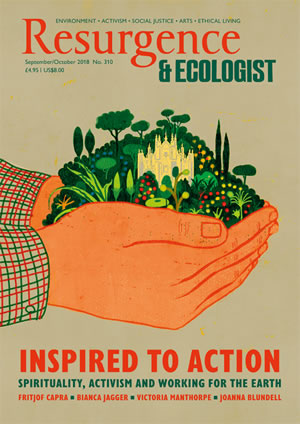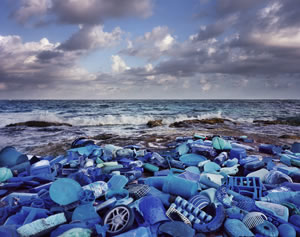David Attenborough said recently: “For years we thought that the oceans were so vast and the inhabitants so infinitely numerous that nothing we could do could have an effect upon them. But now we know that was wrong. The oceans are under threat now as never before in human history.”
The Earth is 70% ocean – the Pacific alone covers half of the planet. The ocean represents 97% of the world’s inhabitable space. However, the largest habitat on Earth – once a fertile ecosystem teeming with biodiversity – has, in the space of barely a century, become a plastic graveyard. If we do not change our habits, we will leave a choked and contaminated world for our children and grandchildren.
For nearly four decades I have campaigned in defence of human rights, social justice and environmental protection. In 2005 I established the Bianca Jagger Human Rights Foundation to be a force for change, and a voice for the most vulnerable.
I was born and grew up in Nicaragua. The ocean has always played an important role in my life. Many of my holidays were spent on pristine beaches; living by the seaside remains my idea of heaven. I am deeply saddened to have witnessed the ever-growing pollution of the world’s oceans and coastlines.
I have long been aware of the dangers of plastics, and I try to minimise my own use of them. In preparing this article, I have brought myself up to date with the enormity of the problem – and was horrified by what I found.
When Bakelite, the world’s first fully synthetic plastic, was invented in 1907 it seemed like a magical material – light, durable and seemingly indestructible. Since then, particularly since the 1940s, different forms of plastic have been incorporated into almost every aspect of our lives. In the last fifty years, plastics production has increased from 15 million to over 320 million tonnes per year. Over the next twenty years it is expected to double again, and to quadruple by 2050. This increase is directly linked to population growth, consumerism and urbanisation across the world. For most purposes, plastics have only short-term uses. For example, we unpack our groceries and often throw the bags and wrappers away, using them just once and ignoring the long-term impacts. Adding further to the wider environmental impacts, some 99% of plastic is produced from chemicals sourced from fossil fuels.
The qualities of plastic, which made it seem a solution to so many requirements of modern life, have now made it the scourge of the ocean. The key problem is that plastic, a long-lived material, is used primarily for short-term purposes, and that disposal rather than reuse or recycling is still the norm. And so a problem that starts on the land ends up in rivers and in the sea. Today, across the developing world, children are forced to wash and swim in a poisonous plastic soup, and to drink contaminated water.
I was appalled to learn that there are some 150 million tonnes of plastic waste in the oceans today – billions of water bottles, plastic bags, discarded fishing nets. We dump the equivalent of a large garbage truck of plastic into the oceans every minute – 8 million tons a year. By 2050, without significant intervention, this plastic debris could weigh more than all the fish in the sea. And there is no way to retrieve most of these plastics and microplastics once they reach the ocean.
Throughout my long years of campaigning for environmental protection I have been told that we must be ‘realistic’ – a word that is often used as an excuse not to take immediate and effective measures. But what should we consider as realistic regarding the ocean plastics crisis? Is it realistic that we drag our feet for ten, twenty or thirty years before taking effective action? Is it acceptable that we defer action on this until the damage is irreversible? Until the weight of plastic in the ocean is more than all the fish that are left?
Plastics pollution is occurring on beaches all over the world, even on islands that have never been inhabited. Currents from the coasts carry plastic out to sea. One of the greatest threats is when plastic degrades into microplastic that lingers in the water indefinitely and is ingested by marine life. Several garbage patches have been observed in the world’s oceans – a diffuse soup of plastic particles mainly consisting of tiny fragments suspended in the water. This debris gradually sinks all the way to the ocean floor.
These tiny particles are now infesting the world’s oceans everywhere. Recent studies of seawater around South Indian islands far from any human habitation show 42 particles of microplastic per cubic metre. Recently microplastic has been found in the body of every single fish brought up from the Mariana Trench in the Pacific, the deepest part of the world’s oceans, 8 kilometres down.
The grave threat to sea creatures through choking and starvation has been well documented recently. It has also been shown that toxic chemicals like persistent organic pollutants, which are already present in the sea from other sources, attach to plastic debris.
The contamination is insidious: it makes its way into sea creatures’ food sources and even into their bloodstreams. No one knows what the long-term effects of microplastic exposure are, but there is no doubt that we should be deeply concerned.
We are reminded that all the oceans are just one vast body of water without any borders. What is dumped in one place is ultimately diffused throughout the whole marine ecosystem. We have to ask ourselves whether there are any pristine marine ecosystems left.
Last year David Attenborough’s wonderful Blue Planet II TV series showed us the heart-breaking image of a mother whale dragging her dead calf at her side for weeks. That iconic image caused an outcry on the news and on social media. We were shocked to learn that the baby whale may have died from toxins in the mother’s milk – which originated from plastics pollution. It was a national moment of horror. We may need more such moments to bring home to us what plastics are doing to the oceans.
If microplastics are pervasive in the marine food chain, are they in our own food chain as well? Scientists have recently estimated that seafood eaters consume up to 11,000 particles of plastic per year. Microplastics are starting to invade our bodies. What will the health effects be?
We’d better stop the harm we are causing to the oceans and to ourselves. We need to clean up our act – and the time is now.
Concrete steps
António Guterres, Secretary-General of the United Nations, said in his opening address to the UN Ocean Conference last year: “Unless we overcome the territorial and resource interests that have blocked progress for far too long, the state of our oceans will continue to deteriorate. We must put aside short-term national gain to prevent long-term global catastrophe. Conserving our oceans and using them sustainably is preserving life itself.”
The global scourge of ocean plastic pollution is killing marine wildlife, from endangered turtles to whales and dolphins, and infesting coral reefs all over the world. But as Oliver Tickell has discovered – see his article There’s a Way; Now We Need the Will in issue 305 of Resurgence & Ecologist – it is also in clear violation of international law by the countries that allow it to take place.
The release of plastic wastes into the oceans is already forbidden by numerous international conventions of both global and regional scope, and by customary law. Although the law is clear, enforcement is not. Small island states, in particular, which are recipients of plastics pollution from larger, richer, more powerful countries, have until now been reluctant to confront them. But it is my hope that this will soon change.
It is clear that we need a paradigm shift in global and national waste management: a change in our uses of both technology and policy, and a definitive shift in our way of life and our thinking.
This also applies to the type of aid and funding that are being made available. For instance, international funding organisations such as multilateral development banks need to be pressured into providing concessionary finance to developing countries to help with measures to deal with plastics contamination.
Meanwhile, we must work fast to clean up our act. These are the minimum measures we need to take, here and now, to curb the torrent of toxic plastic entering the oceans:
1 Eliminate single-use plastic packaging and find sustainable alternative materials such as card, paper or vegetable products that can be composted.
2 Introduce incentives for the collection and recycling of plastic packaging. Beverage container deposit–return systems are one successful example.
3 Improve the collection and recovery systems in high-leakage countries all over the world. Enable these countries to appropriately manage the plastic waste they produce.
4 Increase the value of plastic waste to incentivise plastics collection in countries where informal systems of waste picking and recycling prevail.
5 Reuse plastic materials instead of discarding them. Assure that they are directed into a reprocessing stream, to be turned into long-lasting products.
Heinrich Zimmer, a German historian of South Asian art, is reputed to have said: “Limitless and immortal, the waters are the beginning and end of all things on Earth.” We have caused irreparable damage to the planet, to the oceans. But hopefully there is still a window of opportunity.
There is no question: the time to take radical and immediate action is now, and we have enough expertise to make a difference. We must do so, for the sake of our children, our grandchildren and future generations.
This article is an edited extract from her introduction to a recent conference in London organised by Herbert Girardet, a Resurgence Trustee. www.apeuk.org/ocean-plastic-crisis-summit.
Bianca Jagger, Herbert Girardet and Satish Kumar will be speaking at the Ways to Peace festival at Tintern Abbey, Wales on 21 September. tinyurl.com/ways-to-peace-2018








